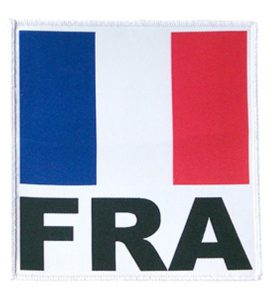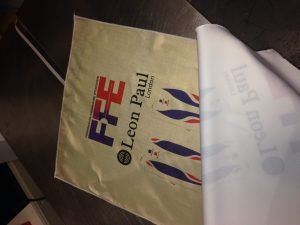We use cookies
Using our site means you agree to the use of cookies and similar technologies. Read about our policy and how to disable them here
[caption id="attachment_395" align="aligncenter" width="840"]For international fencing the FIE requires fencers to have a country identification logo on both of the fencers legs and sometimes arms. Each fencing federation designs their own logo and then submits this to the FIE for approval. Some federations have complex designs that are on the legs and arms and some have simple designs only on the leg. The general rule of thumb would be the more complex the logo and in the more locations the more expensive it is for the fencer. You can see the latest approved FIE versions here: http://static.fie.org/uploads/9/48397-Logos%20des%20tenues%20FN.pdf Here is a video showing the main methods of applying logos: https://www.youtube.com/watch?v=Hohcu0_WK5I There are 4 main ways to apply the logos and each method has advantages and disadvantages. Patch [caption id="attachment_396" align="alignright" width="272"]Heat press, Spray or Patch?[/caption]
 The French National uniform patch[/caption]
A sew on patch is the most permanent method of applying the logo. The patches are washable and do not fade. If the design is small then it is unrestrictive and easy to apply with a needle and thread. For Epee the patch can create a catching point for the blades so some Epee fencers prefer other methods of application. If the design is very big then the patch can restrict movement and make the garment hotter. Also price is dependent on volume so for larger federations companies can buy 100s of patches at a time making the cost per patch lower. For smaller federations patches can be very expensive due to the low order quantities.
Spray or Stencil
This involves cutting out a vinyl stencil and spraying the design on using ink or paint. This is great for simple designs with only 1 or 2 colours but can be very time consuming and therefore expensive for more complex designs. The spray will always wash out over time and look faded, this can happen within only a few weeks if the garment is heavily used. The advantage with spraying is that it is totally smooth so has no catching point for epee and it is both flexible and very breathable.
Direct to garment printing
[caption id="attachment_398" align="alignleft" width="300"]
The French National uniform patch[/caption]
A sew on patch is the most permanent method of applying the logo. The patches are washable and do not fade. If the design is small then it is unrestrictive and easy to apply with a needle and thread. For Epee the patch can create a catching point for the blades so some Epee fencers prefer other methods of application. If the design is very big then the patch can restrict movement and make the garment hotter. Also price is dependent on volume so for larger federations companies can buy 100s of patches at a time making the cost per patch lower. For smaller federations patches can be very expensive due to the low order quantities.
Spray or Stencil
This involves cutting out a vinyl stencil and spraying the design on using ink or paint. This is great for simple designs with only 1 or 2 colours but can be very time consuming and therefore expensive for more complex designs. The spray will always wash out over time and look faded, this can happen within only a few weeks if the garment is heavily used. The advantage with spraying is that it is totally smooth so has no catching point for epee and it is both flexible and very breathable.
Direct to garment printing
[caption id="attachment_398" align="alignleft" width="300"] Direct to garment printing on lame cloth[/caption]
Leon Paul have a direct to garment printer that can print full colour complex logos onto fencing gear. Any design and any picture can be printed, we can even do full colour photos. It is more permanent than spraying but it does wash off. More importantly it needs to be heat sealed onto the garment. This means heating the cloth up to temperatures which are fine for some fencing fabrics but not for others. For example the team range will heat press to the required temperature but the Apex cannot have the required level of heat applied to it as it will melt. See the video of the printer in action here:
https://www.facebook.com/leonpaulfencing/videos/10150353304564978/
Heat Press patch
This is flat and holds its colour very well, it is very flexible and is easy to apply but again it needs some heat so it will work for the Apex range but struggles with the London range material. The patch is effectively coloured glue and the hotter the glue is the more it sinks into the fabric and bonds. Also the patch cannot be put over seams so does not work well on uniforms with a seam on the outside of the leg or arm.
To sum up the best method depends on the weapon you fence, the design and the type of fabric used in the garment. Generally I prefer sew on patches wherever possible however, like most things in fencing it is not as simple as it first seems! For advice please email [email protected] and we can try to help if we can.
Direct to garment printing on lame cloth[/caption]
Leon Paul have a direct to garment printer that can print full colour complex logos onto fencing gear. Any design and any picture can be printed, we can even do full colour photos. It is more permanent than spraying but it does wash off. More importantly it needs to be heat sealed onto the garment. This means heating the cloth up to temperatures which are fine for some fencing fabrics but not for others. For example the team range will heat press to the required temperature but the Apex cannot have the required level of heat applied to it as it will melt. See the video of the printer in action here:
https://www.facebook.com/leonpaulfencing/videos/10150353304564978/
Heat Press patch
This is flat and holds its colour very well, it is very flexible and is easy to apply but again it needs some heat so it will work for the Apex range but struggles with the London range material. The patch is effectively coloured glue and the hotter the glue is the more it sinks into the fabric and bonds. Also the patch cannot be put over seams so does not work well on uniforms with a seam on the outside of the leg or arm.
To sum up the best method depends on the weapon you fence, the design and the type of fabric used in the garment. Generally I prefer sew on patches wherever possible however, like most things in fencing it is not as simple as it first seems! For advice please email [email protected] and we can try to help if we can.
